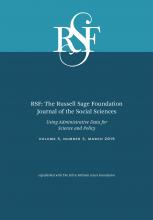Research Article
Open Access
Differing Views of Equity: How Prospective Educators Perceive Their Role in Closing Achievement Gaps
Emily K. Penner, Jane Rochmes, Jing Liu, Sabrina M. Solanki, Susanna Loeb
RSF: The Russell Sage Foundation Journal of the Social Sciences March 2019, 5 (3) 103-127; DOI: https://doi.org/10.7758/RSF.2019.5.3.06
Emily K. Penner
aAssistant professor of education at the University of California, Irvine
Jane Rochmes
bAssistant professor of sociology at Christopher Newport University
Jing Liu
cPostdoctoral research associate in the Annenberg Institute at Brown University
Sabrina M. Solanki
dDoctoral candidate in the School of Education at the University of California, Irvine
Susanna Loeb
eDirector of the Annenberg Institute and professor of education and international and public affairs at Brown University

REFERENCES
- ↵
- Alvidrez, Jennifer, and
- Rhona S. Weinstein
- ↵
- Baker, Courtney N.,
- Marianne H. Tichovolsky,
- Janis B. Kupersmidt,
- Mary Ellen Voegler-Lee, and
- David H. Arnold
- ↵
- Balter, Dana, and
- William Duncombe
- ↵
- Bettinger, Eric,
- Jing Liu, and
- Susanna Loeb
- ↵
- Bireda, Saba, and
- Robin Chait
- ↵
- Bourdieu, Pierre
- ↵
- Boyd, Donald J.,
- Hamilton Lankford,
- Susanna Loeb, and
- James Wyckoff
- ↵
- Brown, Catherine, and
- Ulrich Boser
- ↵
- Buehl, Michelle M., and
- Jori S. Beck
- ↵
- Calarco, Jessica McCrory
- ↵
- California Department of Education
- ↵
- California Department of Education
- ↵
- California Department of Education
- ↵
- Coburn, Cynthia E
- ↵
- Coburn, Cynthia E
- ↵
- ↵
- DeArmond, Michael,
- Betheny Gross, and
- Dan Goldhaber
- ↵
- Dee, Thomas S
- ↵
- Dee, Thomas S
- ↵
- Downey, Douglas B., and
- Shana Pribesh
- ↵
- Egalite, Anna J., and
- Brian Kisida
- ↵
- ↵
- Ferguson, Ronald F
- ↵
- ↵
- ↵
- ↵
- ↵
- Gentzkow, Matthew,
- Bryan T. Kelly, and
- Matt Taddy
- ↵
- Gershenson, Seth,
- Cassandra Hart,
- Constance Lindsay, and
- Nicholas W. Papageorge
- ↵
- Golann, Joanne W.
- ↵
- Goldhaber, Dan,
- Cyrus Grout, and
- Nick Huntington-Klein
- ↵
- Harris, Douglas N., and
- Carolyn D. Herrington
- ↵
- Hollingsworth, Sandra
- ↵
- Jacob, Brian,
- Jonah E. Rockoff,
- Eric S. Taylor,
- Benjamin Lindy, and
- Rachel Rosen
- ↵
- Jockers, Matthew
- ↵
- Jones, Dawn S
- ↵
- Kelly, Sean,
- Andrew M. Olney,
- Patrick Donnelly,
- Martin Nystrand, and
- Sidney K. D’Mello
- ↵
- King, John B., Jr..,
- Amy McIntosh, and
- Jennifer Bell-Ellwanger
- ↵
- Labaree, David F
- ↵
- Lindsay, Constance A., and
- Cassandra M. D. Hart
- ↵
- Liu, Jing
- ↵
- Ludwig, Jens
- ↵
- McFarland, Daniel A.,
- Dan Jurafsky, and
- Craig Rawlings
- ↵
- McGrady, Patrick B., and
- John R. Reynolds
- ↵
- Murphey, David
- ↵
- National Center for Education Statistics
- ↵
- ↵
- Okonofua, Jason A.,
- David Paunesku, and
- Gregory M. Walton
- ↵
- Opfer, V. Darleen, and
- David Pedder
- ↵
- Pajares, M. Frank
- ↵
- ↵
- Reardon, Sean F.
- ↵
- ↵
- ↵
- Rimm-Kaufman, Sara E.,
- Melissa D. Storm,
- Brook E. Sawyer,
- Robert C. Pianta, and
- Karen M. LaParo
- ↵
- Rist, Ray
- ↵
- Rivera, Lauren A.
- ↵
- Roberts, Margaret E.,
- Brandon M. Stewart, and
- Dustin Tingley
- ↵
- Rochmes, Jane
- ↵
- Rockoff, Jonah E.,
- Brian A. Jacob,
- Thomas J. Kane, and
- Douglas O. Staiger
- ↵
- Saavedra, Juan,
- Dario Maldonado,
- Lucrecia Santibanez, and
- Luis Omar Herrera Prada
- ↵
- Senter, R. J., and
- Edgar A. Smith
- ↵
- Smagorinsky, Peter,
- Leslie Susan Cook,
- Cynthia Moore,
- Alecia Y. Jackson, and
- Pamela G. Fry
- ↵
- ↵
- Templin, Mildred C
- ↵
- ↵
- Wilkins, Jesse L. M.
In this issue
Differing Views of Equity: How Prospective Educators Perceive Their Role in Closing Achievement Gaps
Emily K. Penner, Jane Rochmes, Jing Liu, Sabrina M. Solanki, Susanna Loeb
RSF: The Russell Sage Foundation Journal of the Social Sciences Mar 2019, 5 (3) 103-127; DOI: 10.7758/RSF.2019.5.3.06
Jump to section
Related Articles
- No related articles found.
Cited By...
- No citing articles found.





